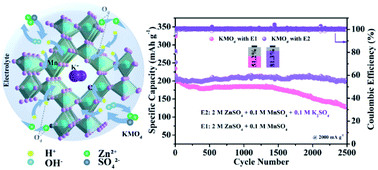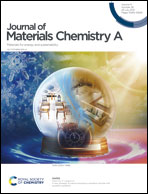High-performance aqueous Zn–MnO2 batteries enabled by the coupling engineering of K+ pre-intercalation and oxygen defects†
Abstract
Aqueous zinc–manganese dioxide (Zn–MnO2) batteries show great promise for grid-scale energy storage but suffer from sluggish reaction kinetics and severe structural instability of the MnO2 cathode. Herein, a K+-pre-intercalated α-MnO2 cathode with oxygen defects (KMOd) is designed, guided by a new coupling engineering strategy, demonstrating boosted reaction kinetics and improved structural stability of MnO2. Closely coupled first-principles calculations and experiments reveal that the synergy effects of pre-intercalated K+ and oxygen defects are key to the high electronic conductivity, favorable H+ diffusion kinetics, enhanced H+/Zn2+ adsorption/intercalation capability, and improved structural stability of the KMOd cathode. A high energy density of 518 W h kg−1 calculated based on the mass of the cathode and outstanding long-term cycling performance of over 2500 cycles at 2.0 A g−1 with a capacity of 203 mA h g−1 and a retention of 81.3% are achieved. New insights into the structural stabilization effect by adding K2SO4 additive into the aqueous electrolyte are also revealed. A hybrid charge storage mechanism of non-diffusion controlled Zn2+ intercalation and diffusion controlled H+ intercalation is proposed.



 Please wait while we load your content...
Please wait while we load your content...